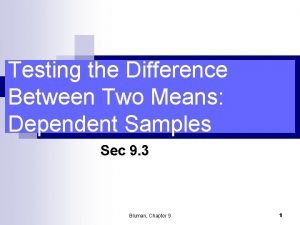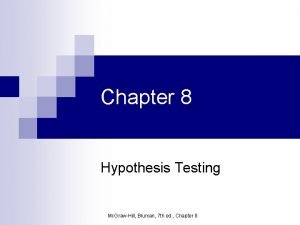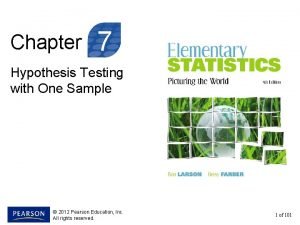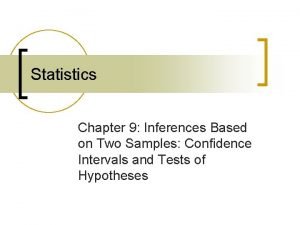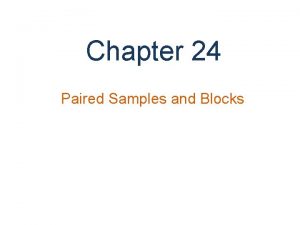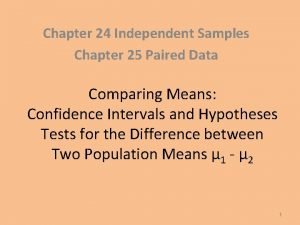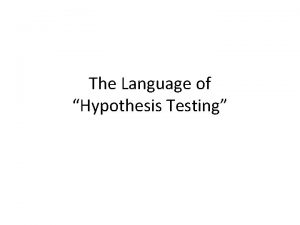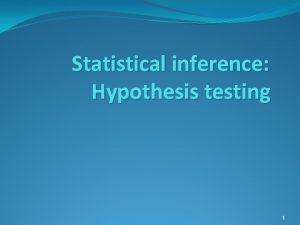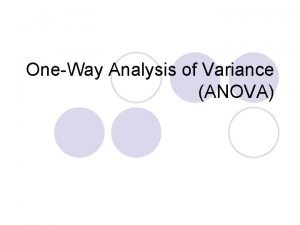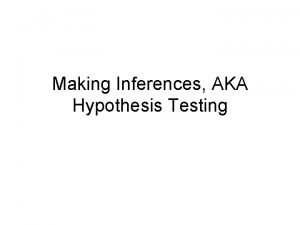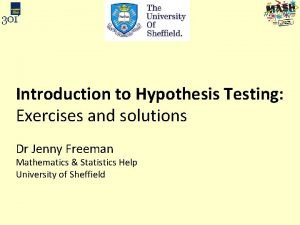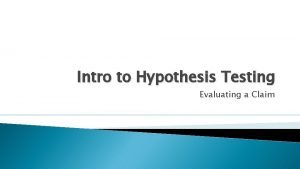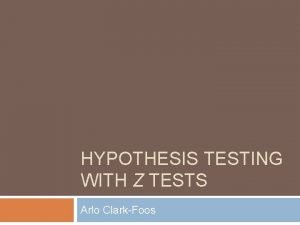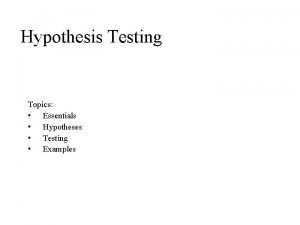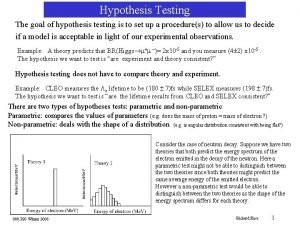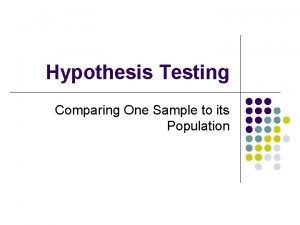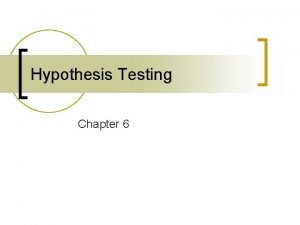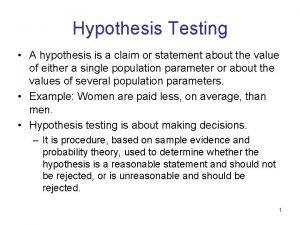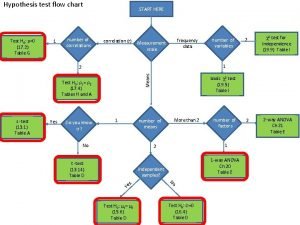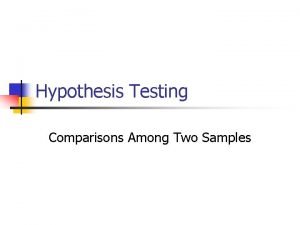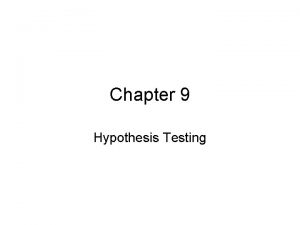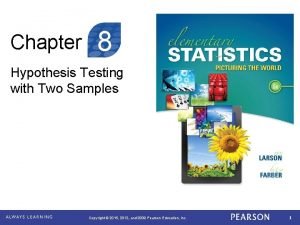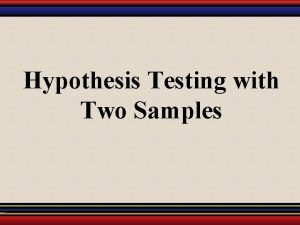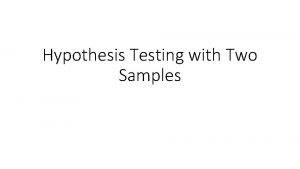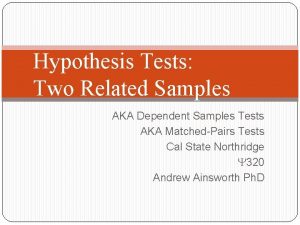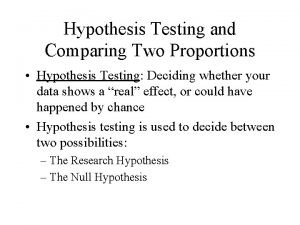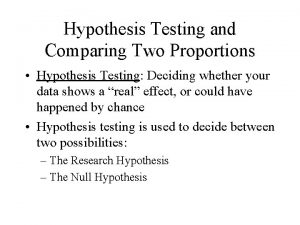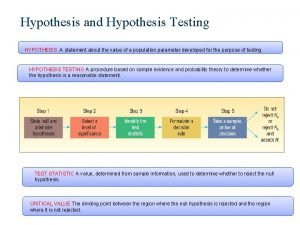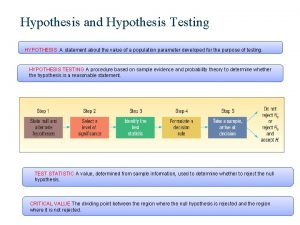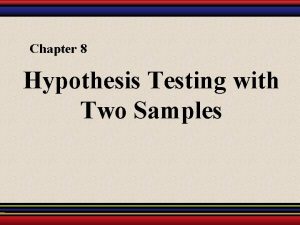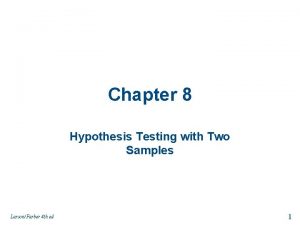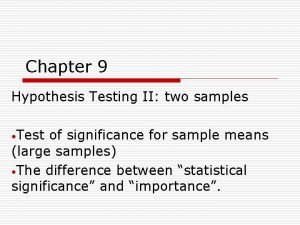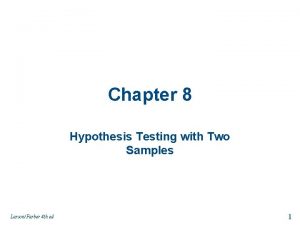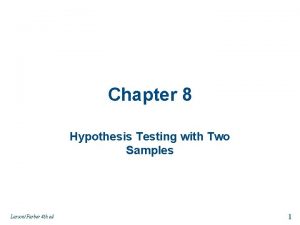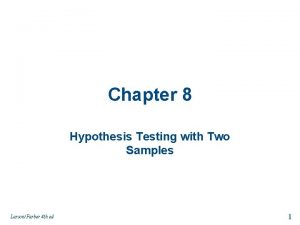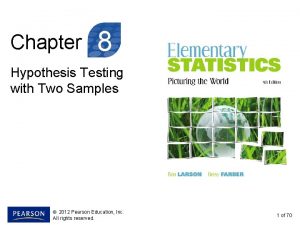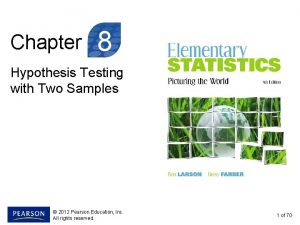Chapter 8 Hypothesis Testing with Two Samples Copyright

























- Slides: 25

Chapter 8 Hypothesis Testing with Two Samples Copyright 2019, 2015, 2012, Pearson Education, Inc. 1

Chapter Outline • 8. 1 Testing the Difference Between Means (Independent Samples, 1 and 2 Known) • 8. 2 Testing the Difference Between Means (Independent Samples, 1 and 2 Unknown) • 8. 3 Testing the Difference Between Means (Dependent Samples) • 8. 4 Testing the Difference Between Proportions . Copyright 2019, 2015, 2012, Pearson Education, Inc. 2

Section 8. 3 Testing the Difference Between Means (Dependent Samples) . Copyright 2019, 2015, 2012, Pearson Education, Inc. 3

Section 8. 3 Objectives • How to perform a t-test to test the mean of the difference for a population of paired data . Copyright 2019, 2015, 2012, Pearson Education, Inc. 4

t-Test for the Difference Between Means • To perform a two-sample hypothesis test with dependent samples, the difference between each data pair is first found: § d = x 1 – x 2 Difference between entries for a data pair • The test statistic is the mean of these differences. Mean of the differences between paired § data entries in the dependent samples . Copyright 2019, 2015, 2012, Pearson Education, Inc. 5

• . t-Test for the Difference Between Means Copyright 2019, 2015, 2012, Pearson Education, Inc. 6

Symbols used for the t-Test for μd Symbol Description n The number of pairs of data d The difference between entries for a data pair, d = x 1 – x 2 The hypothesized mean of the differences of paired data in the population . Copyright 2019, 2015, 2012, Pearson Education, Inc. 7

Symbols used for the t-Test for μd Symbol Description The mean of the differences between the paired data entries in the dependent samples sd The standard deviation of the differences between the paired data entries in the dependent samples . Copyright 2019, 2015, 2012, Pearson Education, Inc. 8

t-Test for the Difference Between Means A t-test can be used to test the difference of two population means when these conditions are met. 1. The samples are random. 2. The samples are dependent (paired). 3. The populations are normally distributed or the number n ≥ 30. . Copyright 2019, 2015, 2012, Pearson Education, Inc. 9

t-Test for the Difference Between Means • The test statistic is • The standardized test statistic is • The degrees of freedom are d. f. = n – 1 . Copyright 2019, 2015, 2012, Pearson Education, Inc. 10

t-Test for the Difference Between Means (Dependent Samples) In Words In Symbols 1. Verify that the samples are random and dependent, and either the populations are normally distributed or n 30. 2. State the claim mathematically and verbally. Identify the null and alternative hypotheses. 3. Specify the level of significance. . State H 0 and Ha. Identify . Copyright 2019, 2015, 2012, Pearson Education, Inc. 11

t-Test for the Difference Between Means (Dependent Samples) In Words In Symbols 4. Identify the degrees of freedom. 5. Determine the critical value(s). 6. Determine the rejection region(s). d. f. = n – 1 Use Table 5 in Appendix B. 7. Calculate and . Copyright 2019, 2015, 2012, Pearson Education, Inc. 12

t-Test for the Difference Between Means (Dependent Samples) In Words In Symbols 8. Find the standardized test statistic and sketch the sampling distribution. 9. Make a decision to reject or fail to reject the null hypothesis. If t is in the rejection region, then reject H 0. Otherwise, fail to reject H 0. 10. Interpret the decision in the context of the original claim. . Copyright 2019, 2015, 2012, Pearson Education, Inc. 13

Example: t-Test for the Difference Between Means A shoe manufacturer claims that the athletes can increase their vertical jump heights using the manufacturer’s training shoes. The vertical jump heights of eight randomly selected athletes are measured. After the athletes have used the training shoes for 8 months, their vertical jump heights are measured again. The vertical jump heights (in inches) for each athlete are shown in the table. At α = 0. 10, is there enough evidence to support the manufacturer’s claim? Assuming the vertical jump heights are normally distributed (Adapted from Coaches Sports Publishing) . Athletes 1 2 3 4 5 6 7 8 Height (old) 24 22 25 28 35 32 30 27 Height (new) 26 25 25 29 33 34 35 30 Copyright 2019, 2015, 2012, Pearson Education, Inc. 14

Solution: Two-Sample t-Test for the Difference Between Means Solution: Because the samples are random and dependent, and the populations are normally distributed, you can use the t-test. The claim is that “athletes can increase their vertical jump heights. ” In other words, the manufacturer claims that an athlete’s vertical jump height before using the shoes will be less than the athlete’s vertical jump height after using the shoes. Each difference is given by d = (jump height before shoes) – (jump height after shoes). The null and alternative hypotheses are H 0: md 0 and Ha: md < 0. (Claim). Copyright 2019, 2015, 2012, Pearson Education, Inc. 15

Solution: Two-Sample t-Test for the Difference Between Means • . Copyright 2019, 2015, 2012, Pearson Education, Inc. 16

Solution: Two-Sample t-Test for the Difference Between Means Before After 24 26 22 25 25 25 28 35 32 30 27 . 29 33 34 35 30 d – 2 – 3 0 d 2 4 9 0 – 1 1 2 4 – 5 25 – 3 9 Σ = – 14 Σ = 56 Copyright 2019, 2015, 2012, Pearson Education, Inc. 17

Solution: Two-Sample t-Test for the Difference Between Means The standardized test statistic is The figure shows the location of the rejection region and the standardized test statistic t. Because t is in the rejection region, you reject the null hypothesis. . Copyright 2019, 2015, 2012, Pearson Education, Inc. 18

Solution: Two-Sample t-Test for the Difference Between Means There is enough evidence at the 10% level of significance to support the shoe manufacturer’s claim that athletes can increase their vertical jump heights using the manufacturer’s training shoes. . Copyright 2019, 2015, 2012, Pearson Education, Inc. 19

Example: t-Test for the Difference Between Means The campaign staff for a state legislator wants to determine whether the legislator’s performance rating (0 – 100) has changed from last year to this year. The table below shows the legislator’s performance ratings from the same 16 randomly selected voters for last year and this year. At = 0. 01, is there enough evidence to conclude that the legislator’s performance rating has changed? Assume the performance ratings are normally distributed. . Copyright 2019, 2015, 2012, Pearson Education, Inc. 20

Solution: t-Test for the Difference Between Means Solution: Because the samples are random and dependent, and the populations are normally distributed, you can use the ttest. If there is a change in the legislator’s rating, then there will be a difference between last year’s ratings and this year’s ratings. Because the legislator wants to determine whethere is a difference, the null and alternative hypotheses are H 0: md = 0 and Ha: md 0. (Claim). Copyright 2019, 2015, 2012, Pearson Education, Inc. 21

Solution: t-Test for the Difference Between Means • . Copyright 2019, 2015, 2012, Pearson Education, Inc. 22

Solution: t-Test for the Difference Between Means • . Copyright 2019, 2015, 2012, Pearson Education, Inc. 23

Solution: t-Test for the Difference Between Means • You can check this result using technology. Copyright 2019, 2015, 2012, Pearson Education, Inc. 24

Solution: t-Test for the Difference Between Means The figure shows the location of the rejection region and the standardized test statistic t. Because t is not in the rejection region, you fail to reject the null hypothesis. There is not enough evidence at the 1% level of significance to conclude that the legislator’s performance rating has changed. . Copyright 2019, 2015, 2012, Pearson Education, Inc. 25
 Testing the difference between two means dependent samples
Testing the difference between two means dependent samples Chapter 8 hypothesis testing
Chapter 8 hypothesis testing Chapter 7 hypothesis testing with one sample answers
Chapter 7 hypothesis testing with one sample answers Inferences based on two samples
Inferences based on two samples Median
Median Hypothesis example
Hypothesis example Developing null and alternative hypothesis
Developing null and alternative hypothesis Null and alternative hypothesis statistics
Null and alternative hypothesis statistics Weakness of protoplanet hypothesis
Weakness of protoplanet hypothesis Chapter 24 paired samples and blocks
Chapter 24 paired samples and blocks Chapter 24 paired samples and blocks
Chapter 24 paired samples and blocks Chapter 25 paired samples and blocks
Chapter 25 paired samples and blocks The language of hypothesis testing
The language of hypothesis testing Inference hypothesis testing
Inference hypothesis testing One way anova test
One way anova test Hypothesis testing assignment
Hypothesis testing assignment Hypothesis testing
Hypothesis testing Critical value hypothesis testing
Critical value hypothesis testing Null hypothesis assumptions
Null hypothesis assumptions P value formula
P value formula Goal of hypothesis testing
Goal of hypothesis testing Test hypothesis definition
Test hypothesis definition Formula for hypothesis testing
Formula for hypothesis testing Six steps of hypothesis testing
Six steps of hypothesis testing What is the claim in hypothesis testing
What is the claim in hypothesis testing Flowchart for hypothesis testing
Flowchart for hypothesis testing
